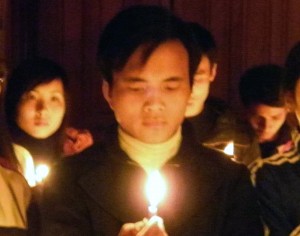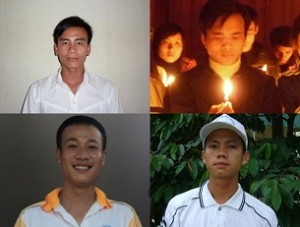Last line of Defence - Tuyến Phòng Thủ Cuối Cùng
Featured
-
Vietnam detains pro-democracy activist: state media
-
TPHCM: Công an bắt giữ Trần Khắc Đức – thành viên của “Tập hợp dân chủ đa nguyên”
-
Liên đoàn Quốc tế các Nhà báo: Không thể có báo chí tự do ở Việt Nam khi bỏ tù Đường Văn Thái!
-
Vietnamese former political prisoners detained after gathering
-
Tù nhân chính trị Nguyễn Đoàn Quang Viên bị lao phổi nặng nhưng không được chữa trị đúng mức
-
Hai người bị khởi tố theo Điều 331 vì sử dụng mạng xã hội chỉ trích lãnh đạo chính quyền và Đảng
-
Người dân kêu gọi Đổi Mới lần hai để khai thông “điểm nghẽn thể chế”
Recent Comments
-
Height Insoles: Hi, I do believe this is an excellent site. I stumbledupon …
-
http://fishinglovers.net: Appreciate you sharing, great post.Thanks Again. Keep writi…
-
Achilles Pain causes: Every weekend i used to pay a quick visit this site, as i w…
Powered by WordPress • Themify WordPress Themes






September 11, 2017
Green resistance mounts in communist Vietnam
by Nhan Quyen • [Human Rights]
Environmental causes have unified Vietnamese social activists across geography, class and ideals, a politically potent convergence the ruling Communist Party is struggling to stop
As Vietnam unleashes yet another crackdown on dissent, the current clampdown underway comes against increasingly bold activists who are uniting across geography, class and ideals. The gravitational force pushing the resistance: the environment.
The country has witnessed several nationwide protests in recent years, galvanized by perceived state involvement in or inaction towards environmentally damaging incidents and projects.
The initial protests date back to the late 2000s, when protestors used the Internet to campaign against China-run bauxite mines that they said were destroying environmentally sensitive areas in the country’s Central Highlands region.
That early movement was emboldened by General Vo Nguyen Giap, a national war hero, who issued three open letters in 2009 claiming the mines would ruin the environment, displace ethnic minorities and threaten national security through an influx of Chinese workers.
Environmental passions came to a head last year when a Taiwanese-owned steel plant spilled tons of toxic waste into the sea, polluting almost 200 kilometers of Vietnam’s central coastline and killing massive quantities of fish. Widely viewed as the country’s worst ever environmental disaster, the incident sparked some of the largest protests seen under over four decades of communist rule.
A government report suggested that the spill affected least 200,000 people, though the indirect number affected is likely much higher. Despite Formosa’s vow to pay almost US$500 million in compensation and an additional US$350 million to improve the factory’s environmental safety, many coastal parts of central Vietnam still haven’t recovered.
Fishermen now rarely ply their trade, fearful their catch will be toxic. Tourism has tanked and investment has stalled in the region. “The Formosa case shows how the government is so corrupt, incompetent and completely bought by foreign interests,” said Tuong Vu, professor of political science at the University of Oregon.
The backlash to the state’s initial lack of response was so strong that independent journalist Huynh Ngoc Chenh predicted the regime had reached its “death point.” While the government has struggled to maintain order, activists have become more emboldened and better connected, including over social media.
In the past, most government critics tended to focus on their own specific causes: workers on forming independent trade unions; urban liberals on pro-democracy causes; villagers on state land confiscations. This is now changing, however, as single issue campaigners are now banding together to create a united coalition against environmental damage.
A human rights defender in Hanoi said the Formosa incident helped to establish closer ties to like-minded rural activists. Rural farmers and workers, in return, now travel to the cities to take part in civil-society training sessions and social gatherings. “Everyone is affected by the environment,” one activist said, “so everyone works together.”
Indeed, the capital Hanoi is now under a cloud of smog for much of the year. In the south, if sea levels rise by 26 centimeters over the next three decades, as the United Nations currently projects, then almost 70% of Ho Chi Minh City, Vietnam’s economic hub, will experience severe flooding. The Asian Development Bank lists the city as one of the world’s ten most vulnerable to flooding.
According to the Vietnamese government’s own estimates as much as a third of the Mekong Delta, the country’s so-called “rice bowl”, will be submerged within decades if sea levels continue to rise. There are already preliminary reports of “climate change refugees” from the region arriving in southern urban centers.
Much of this is outside the government’s control; other issues are not. In 2015, the government found several villages that experienced exceptionally high rates of cancer, likely due to lead contamination in water supplies. Indeed, The Economist recently reported that as much as two-thirds of industrial wastewater flows into lakes and rivers.
A mass fish death has been found during the week-end at the lake due to its highly polluted water, according to the local media. Photo: AFP/Hoang Dinh Nam
But even if the government wants to shift environmental course, it faces structural difficulties to change. A pillar of doi moi, the free-market reforms introduced in 1986, was decentralization of power.
The central government has thus struggled to prevent environmentally damaging activities such as deforestation at the local level. “Whereas smog fighters in Beijing have begun closing factories and restricting car usage,” The Economist wrote, “bigwigs in Hanoi still struggle to prevent scooter-riders from parking on the pavements.”
Environmental activism has altered the political landscape in two important ways, analysts say. First, ordinary Vietnamese can avoid issues like democracy and human rights, which don’t necessarily impact on their everyday lives, but environmental problems do.
Second, environmentalism is different from other conceptual causes because of its immediacy. The Communist Party can likely go on denying citizens democracy for decades, but Hanoi’s smog, Ho Chi Minh City’s floods and industrial pollution in several regions is being felt now and will only worsen without an active government response.
Some pundits, however, are skeptical that a broad-based environmental movement can be sustained. “These types of coalitions eventually dissipate and do not form an existential threat to one-party rule,” Carlyle Thayer, a Vietnam expert at the University of South Wales, told Asia Times.
Many point to the events of January 2012 as an example. That month, a former solider-turned-farmer named Doan Van Vuon and fellow villagers attacked the police with homemade guns and bombs during an attempted land confiscation to make way for a new luxury development near the port city of Hai Phong.
“That, too, brought together hundreds of activists who had many concerns beyond land confiscation,” said Benedict Kerkvleit, a professor at the Australian National University’s department of political and social change. In the immediate aftermath, it appeared as though it would compel political reforms, he added. Indeed, then-Prime Minister Nguyen Tan Dung called for changes in land management policies.
However, the movement of activists that formed around Vietnam’s most visible land dispute soon petered out “because authorities were able to undermine or wait out the clamor,” Kerkvleit said.
Authorities are now clearly trying to undermine activists’ efforts again. While the recent crackdown has witnessed several arrests and harsh prison sentences, including for anti-Formosa protest leaders, the government is also using plainclothes “thugs”, likely from the police or military, to attack outspoken environmental and other activists.
Human Rights Watch notes attacks have often taken place when activists are “carrying out acts in support of fellow activists, such as visiting a recently released political prisoner or attending a wedding of a rights campaigner.”
Still, some maintain that the momentum gained following the Formosa spill is far stronger than any of these earlier events. Academic Tuong Vu thinks politics has become more confrontational since the 2000s and environmentalism has taken it to a new level, with “more articulate and daring domestic critics” willing to challenge the government.